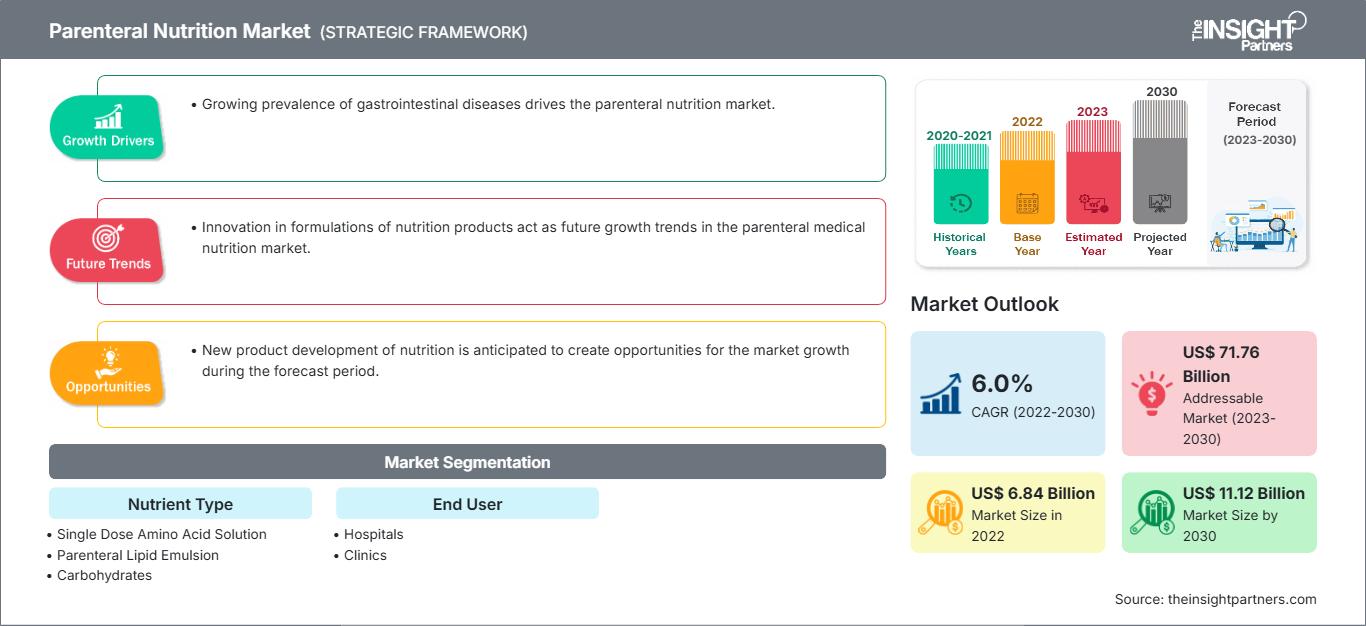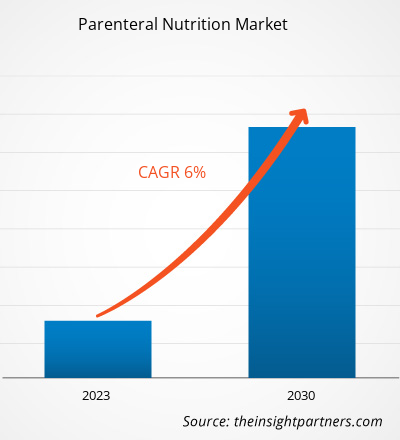预计到 2030 年,肠外营养市场规模将从 2022 年的 68.4 亿美元增至 111.2 亿美元。预计该市场在 2022 年至 2030 年期间的复合年增长率为 6.0%。营养产品配方的创新可能仍将是市场的一个主要趋势。
肠外营养市场分析
胃肠道疾病患病率的上升以及营养不良和早产病例的激增是市场发展的主要驱动因素。此外,营养产品配方的创新对于肠外营养市场参与者来说是一个重要机遇。
肠外营养市场概览
克罗恩病、肠梗阻、溃疡性结肠炎、短肠综合征、显微镜下结肠炎和胃癌是胃肠道疾病的几个例子。根据2021年1月发布的《罗马基金会全球研究结果:功能性胃肠病的全球患病率和负担》,功能性胃肠病已影响全球超过40%的人口。根据2019年全球疾病负担研究,2019年全球记录了约490万例炎症性肠病 (IBD) 病例。中国(911,405例)和美国(762,890例)的病例数最多,每10万人的患病率分别为66.9例和245.3例。溃疡性结肠炎和克罗恩病是两种常见的IBD。克罗恩病是一种复杂的慢性疾病,主要影响消化系统。它是北美和欧洲最常见的疾病。
自定义此报告以满足您的要求
您将免费获得任何报告的定制,包括本报告的部分内容,或国家级分析、Excel 数据包,以及为初创企业和大学提供超值优惠和折扣
肠外营养市场: 战略洞察

- 获取本报告的主要市场趋势。这个免费样本将包括数据分析,从市场趋势到估计和预测。
您将免费获得任何报告的定制,包括本报告的部分内容,或国家级分析、Excel 数据包,以及为初创企业和大学提供超值优惠和折扣
肠外营养市场: 战略洞察

- 获取本报告的主要市场趋势。这个免费样本将包括数据分析,从市场趋势到估计和预测。
肠外营养市场驱动因素和机遇
营养不良和早产病例激增
营养不良包括营养不足、超重或肥胖、维生素或矿物质摄入不足以及因饮食不良而患上非传染性疾病。根据世界卫生组织 (WHO) 的数据,2021 年全球约有 19 亿成年人超重或肥胖,而体重不足的人数为 4.62 亿。此外,5 岁以下儿童超重 3900 万,因饮食中长期缺乏营养丰富的食物而导致生长发育迟缓,1.49 亿儿童消瘦(身高偏瘦)。此外,5 岁以下儿童死亡人数中约有 45% 与营养不足有关。根据联合国国际儿童紧急基金会 (UNICEF) 2022 年 7 月的数据,营养不良发生率从 2019 年的 8.0% 上升至 2020 年的 9.3%;2021 年则进一步跃升至 9.8%。
各公司新产品开发
肠外医学营养市场的公司不断关注新产品的推出,这有助于他们提高销售额。以下是肠外营养市场的一些值得关注的发展:
- 2022 年 12 月,百特国际公司 (Baxter International Inc.) 在美国推出了 ExactaMix Pro 自动混配机。该公告是在美国卫生系统药剂师协会 (ASHP) 2022 年年中临床会议上发布的。该产品于2023年初首次亮相。最近发布的产品利用尖端复合技术来提高患者安全性、工艺有效性和配方准确性。
- 2022年3月,费森尤斯卡比的SMOFlipid脂质注射乳剂获得美国食品药品监督管理局(FDA)的批准。该乳剂用于为儿科患者(包括足月新生儿和早产新生儿)提供肠外营养,这使其成为首个也是唯一一个用于需要肠外营养的儿科患者的四油脂肪乳剂。
因此,预计营养领域的新产品开发将在预测期内为市场增长创造机会。
肠外营养市场报告细分分析
有助于得出肠外营养市场分析的关键细分市场是产品、用途和最终用户。
- 根据营养素类型,肠外营养市场细分为单剂量氨基酸溶液、肠外脂肪乳剂、碳水化合物、微量元素、维生素和矿物质。单剂量氨基酸溶液细分市场在2022年占据了最大的市场份额。
- 根据最终用户,肠外营养市场细分为医院、诊所和其他。 2022 年,医院部门占据了最大的市场份额。
按地区划分的肠外营养市场份额分析
肠外营养市场报告的地理范围主要分为五个区域:北美、亚太地区、欧洲、中东和非洲以及南美和中美。
在北美,美国肠外营养市场占有最大的份额。癌症、心脏病和其他慢性疾病是美国致残和死亡的主要原因。根据国家慢性疾病预防和健康促进中心的数据,该国每 10 人中就有 6 人被诊断出患有至少一种慢性疾病。此外,美国医院协会估计,约有 1.33 亿人患有至少一种慢性疾病,预计到 2030 年这一数字将达到 1.7 亿。根据 2019 年 1 月发表的一篇题为《肠外营养趋势》的文章;美国每年平均约有3.4万名患者接受肠外营养 (PN)。肠内管饲可用于治疗350多种儿童疾病。
肠外营养肠外营养市场区域洞察
The Insight Partners 的分析师已详尽阐述了预测期内影响肠外营养市场的区域趋势和因素。本节还讨论了北美、欧洲、亚太地区、中东和非洲以及南美和中美洲的肠外营养市场细分和地域分布。
肠外营养市场报告范围
| 报告属性 | 细节 |
|---|---|
| 市场规模 2022 | US$ 6.84 Billion |
| 市场规模 2030 | US$ 11.12 Billion |
| 全球复合年增长率 (2022 - 2030) | 6.0% |
| 历史数据 | 2020-2021 |
| 预测期 | 2023-2030 |
| 涵盖的领域 |
By 营养类型
|
| 覆盖地区和国家 | 北美
|
| 市场领导者和主要公司简介 |
|
肠外营养市场参与者密度:了解其对业务动态的影响
肠外营养市场正在快速增长,这得益于终端用户需求的不断增长,而这些需求的驱动因素包括消费者偏好的演变、技术进步以及对产品益处的认知度的提升。随着需求的增长,企业正在扩展产品线,不断创新以满足消费者需求,并抓住新兴趋势,从而进一步推动市场增长。

- 获取 肠外营养市场 主要参与者概述
肠外营养市场新闻及最新动态
肠外营养市场评估通过收集一手和二手研究的定性和定量数据进行,这些数据包括重要的公司出版物、协会数据和数据库。肠外营养市场的一些发展如下:
- 百特国际公司获得美国食品药品监督管理局 (FDA) 批准扩大 Clinolipid(脂质注射乳剂)的适应症,可用于儿科患者,包括早产儿和足月新生儿。Clinolipid 是百特专有的混合油脂质乳剂,用于在无法进行口服或肠内营养、营养不足或有口服或肠内营养禁忌症时,通过肠外(静脉)营养 (PN) 提供热量和必需脂肪酸。Clinolipid 自 2019 年起在美国面向成人上市,现已面向所有年龄段人群使用。 (来源:百特国际公司,公司网站,2020 年 1 月)
肠外营养市场报告覆盖范围和交付成果
“肠外营养市场规模和预测(2020 年–2030 年)”报告提供了涵盖以下领域的市场详细分析:
- 肠外营养市场规模以及涵盖范围内所有主要细分市场的全球、区域和国家/地区预测
- 肠外营养市场趋势以及市场动态,例如驱动因素、限制因素和关键机遇
- 详细的 PEST/Porter 五力模型和 SWOT 分析
- 肠外营养市场分析涵盖主要市场趋势、全球和区域框架、主要参与者、法规和最新市场发展。
- 行业格局和竞争分析涵盖市场集中度、热图分析、知名参与者和肠外营养市场的最新发展
- 详细的公司简介
- 历史分析(2 年)、基准年、预测(7 年)及复合年增长率
- PEST和SWOT分析
- 市场规模、价值/数量 - 全球、区域、国家
- 行业和竞争格局
- Excel 数据集
近期报告
客户评价
购买理由
- 明智的决策
- 了解市场动态
- 竞争分析
- 客户洞察
- 市场预测
- 风险规避
- 战略规划
- 投资论证
- 识别新兴市场
- 优化营销策略
- 提升运营效率
- 顺应监管趋势




















 获取免费样品 - 肠外营养市场
获取免费样品 - 肠外营养市场